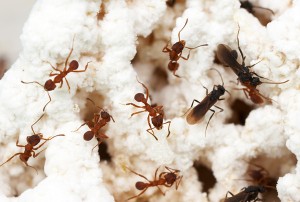For a leaf-cutter ant, the answer to that question is not so much “silver bells and cockle-shells” as it is “one nutritious fungus and a variety of beneficial bacteria.” It may not exactly be the stuff of nursery rhymes, but it’s certainly a fascinating three-way mutualism that makes for a great lesson in microbial ecology, and ecology in general, for that matter.
Fungiculture, as it’s called, involves production of food or medicine by cultivating mushrooms or other fungi . In the insect world, fungiculture is practiced by ambrosia beetles, termites, and gall midges, in addition to leaf-cutter (or attine) ants. That’s right, millions of years before humans even thought about any type of agriculture, these insects evolved the ability to grow fungi for food (Mueller and Gerardo, 2002).
Attine ants grow their fungal gardens in underground caverns or chambers and supply the fungus with leaf fragments from live plants collected aboveground. They literally “feed the fungus” and in return, their larvae are reared exclusively on the fungus itself. So, the ants provide the fungus with food, protection, and dispersal (fungal spores remain viable within the ant digestive tract and can be deposited via ant dung during the daily travels) while the fungus provides a high-quality food source with increased nutrition and survival for the ants.
Much like humans, these insect farmers have become dependent on cultivated crops and have even developed task-partitioned societies. And, just like our crops, theirs can be wiped out by parasites and pests (nematodes and mites), their harvest ruined by weeds and disease (unwanted/harmful fungal species), which can lead to collapse of the colony.
To protect their fungal gardens, the ants have developed specialized behaviors like grooming and weeding the fungus, as well as producing their own antimicrobials through gland secretions, as well as large-scale application of weed killers. Only, in this case, when I say “weed killers” I’m not talking about synthetic chemicals like RoundUp, I’m talking about specialized soil bacteria which produce potent antimicrobial compounds with specificity towards the unwanted fungal species. (Barke, et a.l 2010).
It’s long been known that the reproductive females in each colony pass on the fungal cultivar, but only recently have we begun to understand that the ant’s gardening toolbox is constantly evolving. Along with the fungus, the queen also passes down at least one species of bacteria (a Pseudonocardia). This particular bacterium produces an antifungal compound, specifically aimed at reducing the most common pest of the fungal gardens but which leaves the crop itself untouched. But beyond that, the gardening ants also pick up a variety of soil bacteria along the way including Streptomyces. In other words, each of the bacteria makes a unique antimicrobial compound that the ants use to their advantage in their agriculture depending on the particular pest the ants are challenged with.
We have leaf-cutter ants, going out into the world each day, chopping down entire forests so they can bring the good stuff home to feed their fungus. The ants survive off this fungus, so it’s carefully cultivated and passed on from generation to generation, and they have specialized farmer-ants who will each spend their whole life tending to the fungal garden. Some of the most important tools these farmers use to keep the fungus healthy and productive include natural soil bacteria. For the worst pests they use a special bacteria, which was also passed on through the generations, but for more common pests, they can use a variety of bacteria collected from their surroundings: different tools for the different problems.
Is that weird?
________________________________________________________________________________________________________________________________________________________________![]() Barke, J., Seipke, R., Grüschow, S., Heavens, D., Drou, N., Bibb, M., Goss, R., Yu, D., & Hutchings, M. (2010). A mixed community of actinomycetes produce multiple antibiotics for the fungus farming ant Acromyrmex octospinosus BMC Biology, 8 (1) DOI: 10.1186/1741-7007-8-109
Barke, J., Seipke, R., Grüschow, S., Heavens, D., Drou, N., Bibb, M., Goss, R., Yu, D., & Hutchings, M. (2010). A mixed community of actinomycetes produce multiple antibiotics for the fungus farming ant Acromyrmex octospinosus BMC Biology, 8 (1) DOI: 10.1186/1741-7007-8-109
Mueller, U. (2002). Fungus-farming insects: Multiple origins and diverse evolutionary histories Proceedings of the National Academy of Sciences, 99 (24), 15247-15249 DOI: 10.1073/pnas.242594799

No hay comentarios:
Publicar un comentario
yesyukan